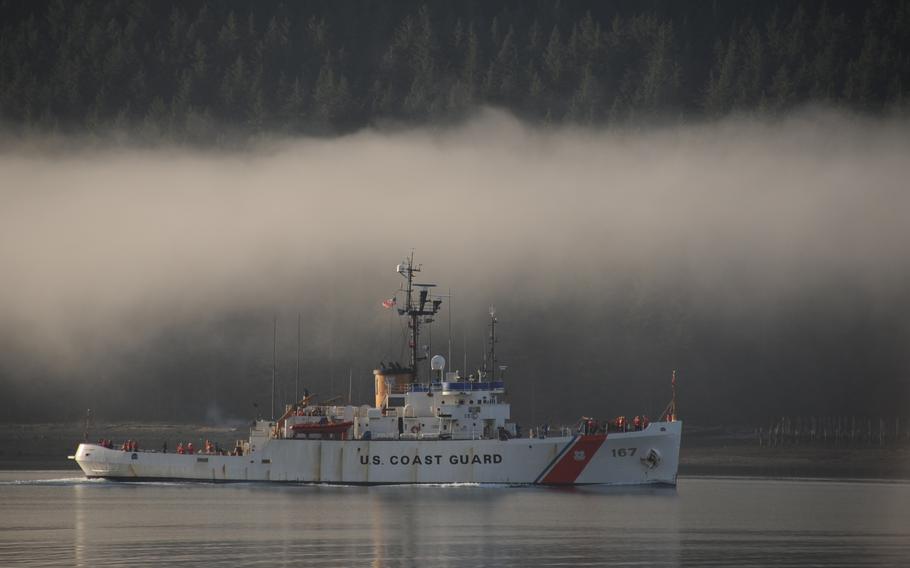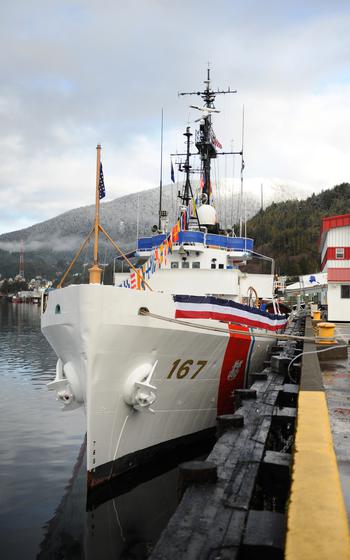The USS Shackle was a Navy rescue and salvage ship during World War II serving in such places as Iwo Jima, Midway and Okinawa. Between April and September of 1945, it completed 55 salvage and rescue missions in the western Pacific Ocean for ships damaged in Japanese kamikaze air attacks. The Shackle became the Coast Guard cutter Acushnet in 1946. (Kirk Fistick/U.S. Navy)
NAPA, Calif. (Tribune News Service) — A World War II-era ship born along the Napa River and tested in harrowing Navy and Coast Guard missions by the dozens looks to have a better future than the scrap heap.
Mark “Doc” Avraham is spearheading efforts to care for the decommissioned boat — named the USS Shackle while in the Navy and Acushnet during its Coast Guard service — at a marina in Tacoma, Washington. He envisions it being a place for homeless veterans to live and train for jobs, and a museum with a café.
And who knows — perhaps the Shackle/ Acushnet could return to the county of its birth. Eight decades ago, Basalt built ships for the Navy at the site of today’s Napa Pipe, recently renamed RiverSound and the planned site for hundreds of homes and a Costco.
“I wonder if Napa has a place for a group like ours?” Avraham asked recently.

The Coast Guard Cutter Acushnet arrives in Juneau, Alaska, for a port visit in February 2010. Acushnet was originally commissioned as a Diver Class Fleet Rescue and Salvage Vessel, USS Shackle, for the Navy on Feb. 5, 1944. In August 1946, Acushnet was commissioned as an Auxiliary Tug (WAT) in the Coast Guard. (Walter Shinn/U.S. Coast Guard)
A long list of honors
Acushnet is 213-feet long and powered by four diesel engines and twin propellers. It has a maximum speed of 14.6 knots, or 17 mph, according to the U.S. Coast Guard.
As the USS Shackle, it served the Navy as a rescue and salvage ship during World War II in such places as Iwo Jima, Midway and Okinawa. Between April and September of 1945, it completed 55 salvage and rescue missions in the western Pacific Ocean for ships damaged in Japanese kamikaze air attacks.
The Shackle became the Coast Guard cutter Acushnet in 1946. In 1952, it helped rescue crews when two tankers both split in half off Cape Cod, Massachusetts. In 1978, it covered 18,000 miles in 82 days gathering data for the Global Weather Experiment.
Its honors are many — Presidential Unit Citation, World War II Victory Medal, Asiatic-Pacific Campaign Medal, four National Defense Service Medals, six Coast Guard Meritorious Unit Commendations, Transportation 9-11 Ribbon and Global War on Terrorism Service Medal, to name a few.
The Coast Guard retired Acushnet in 2011, and the federal government declared it surplus property. A man bought it for $600,825 in March of that year, according to a Coast Guard historian.
Various reports, including one in the Seattle Post-Intelligencer, said the buyer duped a widow out of money for the purchase. Initial attempts to find a new use for the ship failed.
Acushnet’s glory days had ended, at least for a time.
Avraham and his son were looking for a ship about two years ago. They had a boat that they used to take veterans, at-risk youth and others fishing and crabbing, but wanted something bigger.
“One day my son and I were driving and saw a homeless vet,” Avraham said. “We stopped to help, made a call to get him emergency shelter and while driving it hit us — we could do more. So we started looking for a ship that would allow us more latitude on what we could do.”
They found Acushnet for sale. The asking price was too high at $230,000, but the owner sold it for $90,000.
The ship is structurally sound and seaworthy, Avraham said. The inside is about 93% in good condition, with such flaws as a hood for a range that doesn’t work.
Avraham has already run a veterans’ program on the ship. He talked of serving people who are looking for direction after leaving the military. The ship is a place to learn skills ranging from electronics to cooking in the galley.
“We have four massive engines they can work on to get a maritime ticket for working on a boat,” he said.

The 67-year-old Cutter Acushnet, the Coast Guard’s “Queen of the Fleet,” is moored to the pier prior to the cutter’s decommissioning ceremony at Base Support Unit Ketchikan on March 11, 2011. (Walter Shinn/U.S. Coast Guard)
‘A time capsule’
Volunteers help maintain Acushnet. Dan DeVaul is among them, taking on such jobs as working on electrical panels.
In 1978 and 1979, DeVaul served in the Coast Guard on the cutter Yocona, a sister ship of Acushnet that Basalt launched into the Napa River in 1944 as the USS Seize. The Navy sank Yocona in October 2005 as part of a training exercise.
When DeVaul helps with electrical work and other chores on Acushnet, he is reminded of his youth serving on Yocona. The two ships were nearly identical, he said.
“It’s kind of like going back in a time capsule when you’re aboard,” said DeVaul.
He’s taken another look at the past. In 2015, he was living in Sacramento and went to what remained of the Basalt shipyard in Napa. He saw such remnants as the four concrete drydocks and took photographs.
“That was the most incredible feeling...You couldn’t believe it was still there,” he said.
Avraham is a San Diego native and went to high school in Sacramento.
“I’m very familiar with Napa. A great place,” he said.
But Avraham hasn’t been to what’s left of the old Basalt shipyard. He said he’d like to see the place where Acushnet was born.
Before Acushnet could be born, however, Basalt Rock Co. had to be born.
Where it all started
The attraction was the hills where today’s Syar quarry is located. Basalt and rhyolite formed there from volcanic eruptions millions of years ago that sent flows down the Napa Valley.
Leo J. Alexander, the son of a pioneer, formed a company to mine the hills in 1914. By 1926, the company was called Basalt Rock Co., had 50 workers and provided crushed rock for paving and reinforced concrete.
Rock had to get from the hills to construction sites. The Napa River provided the transportation. Basalt built a cable tram system that carried buckets of rock for nearly two miles to the riverbank.
“The cable crosses the state highway and frequently excites the interest and curiosity of travelers on the highway,” said the 1926 book “History of Solano and Napa Counties.”
Albert Streblow soon joined Alexander in the quarrying operation and eventually became the company’s first president. Today, his name graces Streblow Drive leading to Napa Valley College and Kennedy Park.
Basalt needed barges to move stones to projects in the San Francisco Bay Area. In 1938, it opened its own shipyard along the Napa River to build steel barges.
Then came World War II. During that era, 15 emergency shipyards were created in the state, 11 of them in the Bay Area. The Basalt yard became part of the war effort.
In August 1940, Streblow announced that Basalt had been awarded a Navy contract to build eight steel barges. That was only the start, with the company in 1941 constructing four dry docks to help with the undertaking. It went on to build minelayers and salvage ships for the Navy.
Here Acushnet was built as the USS Shackle. Its launching along with two other ships on April 1, 1943, made local headlines. According to the Navy, this marked the first one-day triple ship christening in the Bay Area since World War I a quarter century earlier.
The Basalt site has been home to other industries over the years, such as Kaiser Steel and Napa Pipe. Today, RiverSound is being built as a community of homes, businesses and a Costco. The industrial past is being traded for a slice of suburbia.
Still, that past isn’t being wiped clean. The four drydocks remain at RiverSound as reminders of another age, when ships such as the Shackle/ Acushnet were built there.
Meanwhile, Acushnet is at The Marina at Brown Point in Tacoma. Avraham said there are such problems as providing the ship with enough electricity.
“My ultimate goal is to find a city or a place where we could park the boat, work on it, possibly go to drydock, start the program, do the museum work, do the homeless program,” he said.
He’s not limiting the search to Washington.
“We’re open to going back home to Napa. That would be great,” Avraham said.
(c)2024 Napa Valley Register, Calif.
Visit www.napavalleyregister.com
Distributed by Tribune Content Agency, LLC.